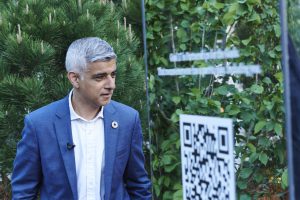June saw Somerset House transformed into an urban oasis. As the central courtyard is taken over by around 450 trees and large shrubs in the Forest for Change.
June saw Somerset House transformed into an urban oasis. As the central courtyard is taken over by around 450 trees and large shrubs in the Forest for Change.
The UN’s sustainable development goals were central to this year’s London Design Biennale. Each pillar represents one of 17 goals and the forest illustrates the multi-benefit impact that landscape and urban greening projects can have on them. Many of our members and practices and the LI itself are committed to implementing the Sustainable Development Goals.
The Forest for Change was conceived by world renowned artist Es Devlin and created by Philip Jaffa founder of Scape Design; an LI member and registered practice. They’ve worked alongside both Urban Green Specialists, Scotscape and Barcham Trees and demonstrate just how beneficial it is to have landscape professionals at the heart of such projects. In a clearing, at the heart of the Forest lies a dynamic art installation by Es, that brings the goals to life.
Not only has it proven to be a spectacular display, the intentions behind the scheme are much bigger and hope to have lasting impact. Does the Forest for Change have the potential to spark a wider revolution of urban greening across our towns and cities?
Philip Jaffa, worked closely with David Johnson of Barcham’s on the selection of the trees, with a connected supply chain organised by Scotscape through to the practical implementation of the project has demonstrated the benefit of collaborative specification at every stage of a project.
The involvement of a landscape professional throughout the development and implementation of the project illustrates the full benefits of this joined up approach as they understand the need for correct specification, considered implementation and legacy planning.
The Forest for Change is working with several London boroughs to rehome the forest at the end of the biennale as part of The Queen’s Green Canopy. This allows the impact of the forest to continue and has meant that it is carbon positive rather than just an exercise in greenwashing.
The Creative journey undertaken by Philip Jaffa in designing the Forest, has truly highlighted both the plight, and changing patterns of use of urban trees species in London, particularly due to Climate Change. With an early realisation that planting a native forest in this urban setting would be almost impossible, because of the loss of major species such as Ash, Oak and even Horse chestnut due to on-going devastation from pests and disease, but also the clear evidence of our hotter summers giving rise to the changing availability of tree species in our nurseries. These changes have led to more than 500 different tree species now being planted on the streets of London today, with an even greater array when observed in our parks.
In conversation with Tony Kirkham MBE VMH, Head of Arboretum, Gardens & Horticulture Services at the Royal Botanic Gardens, Kew, Tony stated that “the only appropriate way to guarantee the future resilience of the trees in our cities is plant as wide a range of species as possible”.
As the future legacy of the Forest was critical, the Forest for Change was eventually created from a beautiful mix of 27 different, but complementary species, many of them native, but with the bulk selected from species that are commonly found today in the UK’s leading trees nurseries grown to specifically target the urban realm.
It is commonly understood that there are multiple benefits to urban greening. Whether that’s connecting greenspaces to create essential biodiversity corridors or playing a key role in CO2 Carbon capture or even providing green infrastructure to play a major role in rainwater retention and in turn flooding reduction.
When it comes to natural capital accounting and measuring success, we as landscape professionals, have the tools available to show just how much benefit trees and other greening schemes can bring.
Those involved in the project have strong track records in each of these areas further demonstrating the benefits of a coordinated, landscape-driven approach. Scotscape for example, regularly deliver tried and tested methods for effective urban greening, whether through similar projects to this or through their living walls and living pillars. Alongside this, Barcham have developed a carbon capture measurement system for trees.
Environmental credit rating system
All this work goes towards ensuring that the multi-benefit impact of these projects is both visible and measurable. This evidence supports the integration of such schemes into future development plans across the country and can influence the decision making of local governments and developers.

This project is particularly timely with Mayor Sadiq Khan having committed to creating two new woodlands spanning over 84 hectares mainly in the Green Belt. In his recent election manifesto, he has committed to more urban greening from green bus shelter roofs to mass-tree planting the mayor is keen to employ a variety of green infrastructure.
Furthermore, the recent England Trees Action Plan calls for an increased focus on urban tree planting and greater involvement of landscape professionals in delivering multi-beneficial woodlands. The LI will be looking to work closely with government to develop and deliver appropriate guidance and equip our members to help deliver these ambitious tree planting targets.
While you might’ve missed this urban oasis, let’s use it as a call to action to create more of these amazing projects.




